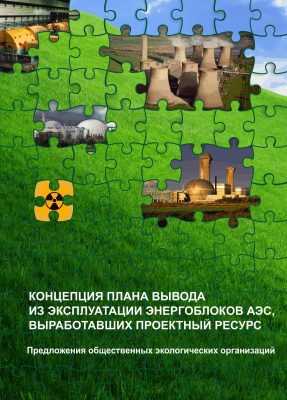3. Recycling of metallic radioactive waste
The recycling of metallic RW and its return to economy is a promising strategy, if the safety of this technology is guaranteed and the users of the recycled metal know the details of its origin.
In some countries the metal produced by recycling radioactive metallic waste is used for manufacturing containers for the RW transportation.
In accordance with expert assessment Russia has accumulated about 600000 t of radioactive waste as high-alloy steels, nonferrous metals and alloys.
In 1995 the Decree of RF Government enacted the target federal program "Recycling of radioactive metallic waste” proposed by the Minatom of Russia.
The RF Government entrusted the Program implementation to the "main contractor”, a private company ZAO "Ecomet-S”. It was planned that, in accordance with the Program, during the period of 1998 - 2002, not less than 4 facilities for the radioactive metal recycling would be put into operation each year, which would have the capacity of up to 35000 t/year. By year 2000 their total capacity would be up to 150 000 t/year. The facilities were to be started near the sources of metallic RW concentration.
The Program was not implemented.
Starting from 1995 in the framework of the Program Ecomet-S engaged in experimental melting of radioactive metal on the territory of LSK Radon (Sosnovy Bor, Leningrad Oblast).
In violation of Russian legislation, that is without the mandatory environmental examination before 2002 Ecomet-S was built and put into operation13. Only one plant for industrial recycling of metallic RW was constructed. The capacity of this plant built on the territory of Leningrad NPP is 6000 t/year.
In the Ecomet-S Declaration of Intent, it was stated that it would melt radioactive metal from Leningrad NPP. But actually the Ecomet-S plant on the LNPP territory accepts radioactive metal from Kursk NPP, nuclear companies of Udmurtia, Murmansk, St. Petersburg, Moscow and Moscow Oblast, also from the oil & gas facilities of Kaliningrad Oblast and Stavropol Territory.
In accordance with different sources the facility operated on the Baltic coast in Sosnovy Bor has reprocessed from 7500 to 11000 t of radioactive metal14 The recycled metal goes to the world market without any restrictions on its use and without any information about its origin.
The low level of safety culture at the company has repeatedly led to explosions at melters, personnel injuries and deaths.
There are reliable scientific data on the negative environmental impact in the area of Ecomet-S. The many-year studies (1997 - 2002) of geneticists from the Russian Institute of Agricultural Radiology and Agroecology (Obninsk) and ecologists of the Khlopin Radium Institute (St. Petersburg) in the Ecomet-S area have revealed the statistically relevant a 2.0 - 2.8 times increase in the occurrence of cytogenetic malformations in tissues of the pine tree seeds and needles in comparison with pine trees growing 40 km East to St. Petersburg16.
Similar cytogenetic malformations (occurrence 2 times higher than normal) were registered in pine trees growing in Sosnovy Bor (5 km to the east from Ecomet-S).
In spite of this the company operation continues, and starting from 2007 Ecomet-S is planning a refurbishment to increase its capacity, widen the inventory of processed RW and geography of contaminated metal shipments.
The refurbishment plan has been approved by the State environmental examination of Rostekhnadzor in spite of the public protests against the import of radioactive waste from all over Russia and other countries to the Baltic coast.
Ecomet-S has signed a contract with Rosenergoatom for the recycling of metallic waste from NPPs operating in other Russian regions. It is also planned to recycle RW from the decommissioned NPPs of Western countries.
In the nearest future it is planned to bring waste from Kola, Novovoronezh, Smolensk, Balakovo and Kalinin NPPs.
Дополнительные материалы
This topic focuses on the existing experience of long-term isolation of radioactive wastes from the environment in Russia
Lectures on this topic:
- 01. Operational RW and SNF of Russian VVER and RBMK reactors
- 02. Generation of solid radioactive waste (SRW)
- 03. Recycling of metallic radioactive waste
- 04. Spent nuclear fuel (SNF)
- 05. Radioactive waste produced at NPP decommissioning
- 06. Necessity of establishing a unified RW management system
- 07. Proposals for establishing regional RW repository in the North-West Russia
- 08. Legal provisions for RW management in Russia
- 09. Importance of using the international experience of RW and SNF management
- 10. European experience
TOPIC OF COURSE
- Topic 01. Current condition of nuclear energy
- Topic 02. Legislation in the US and in Russia
- Topic 03. International law in the sphere of decommissioning
- Topic 04. Role of the national regulators in the decommissioning process
- Topic 05. Possible approaches and scenarios of decommissioning
- Topic 06. Existing experience of decommissioning
- Topic 07. Strategy for handling radioactive waste (RW) and spent nuclear fuel (SNF) USA experience
- Topic 08. Strategy for handling RW and SNF Russian experience & other countries
- Topic 09. Social aspects of decommissioning
- Topic 10. International and inter-regional cooperation for safe decommissioning
